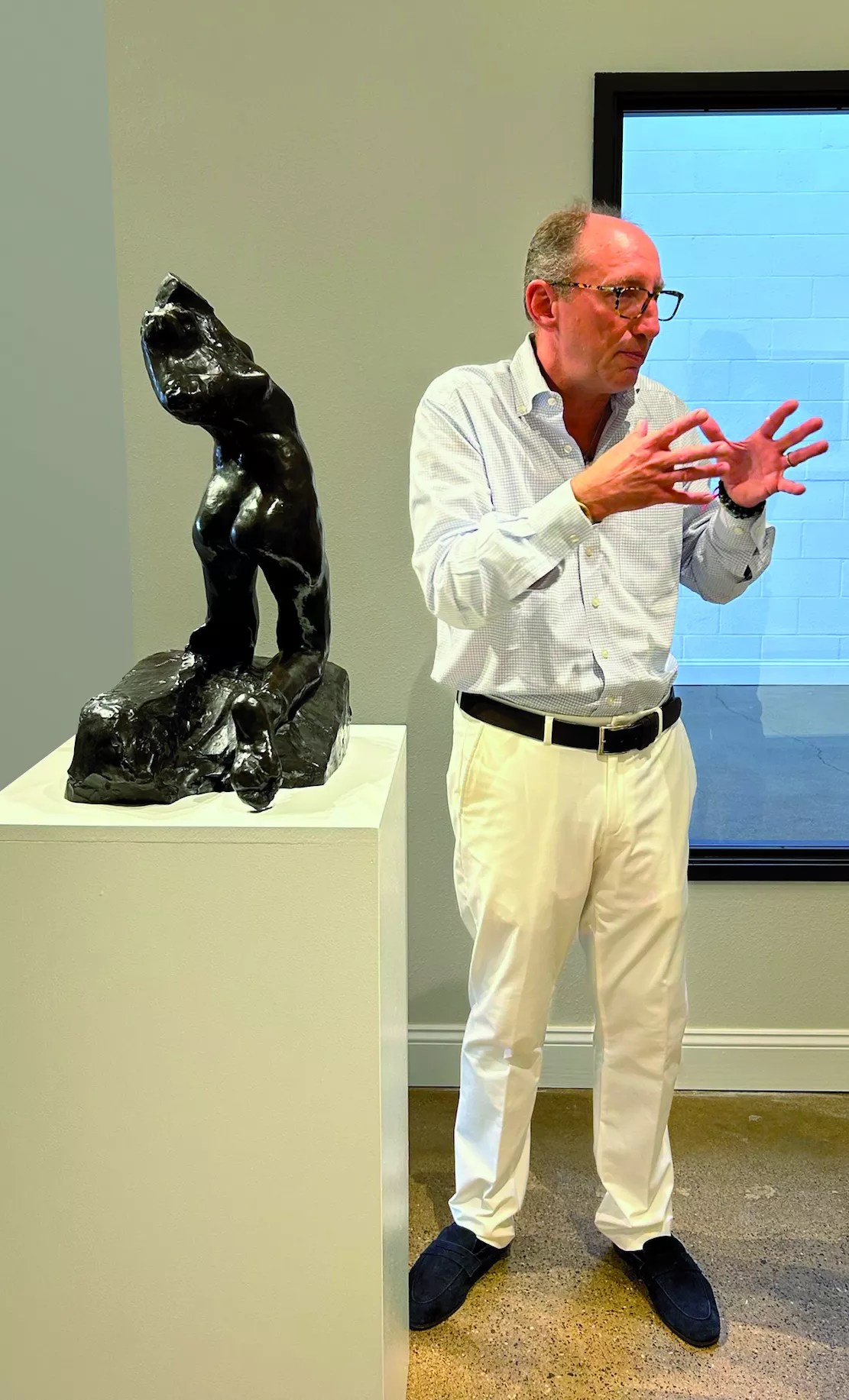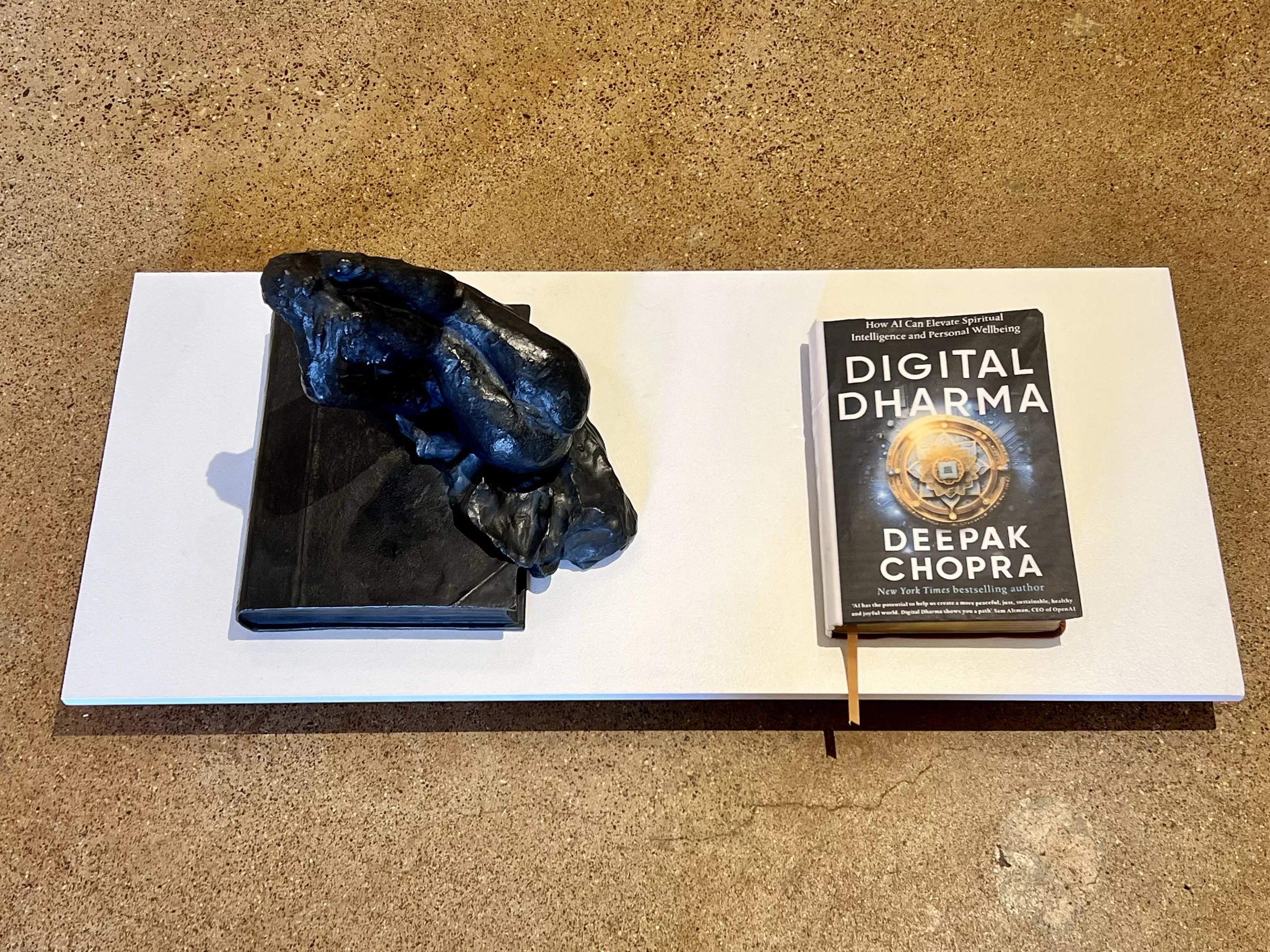
Akim Monet

Audio By Carbonatix
Considered the greatest portraitist in the history of sculpture, Auguste Rodin was known for his ability to strip away the narrative of classical myths to create complex, textural figures of bronze and marble.
Yet even within his rougher forms, there were works that his late-19th-century audience simply couldn’t understand, considering them unfinished or incomplete. But what was considered unfinished or incomplete then is now highly prized for its revelation of the thought process and technique possessed by the legendary sculptor.
These elements were always one of the most interesting aspects for Swiss-born gallerist Akim Monet. Having opened his eponymous Design District space in August, he is mounting his second show in the gallery with an exhibition that explores this aspect of Rodin while placing him within the firmament of modern society, with its digital assistants and artificial intelligence.
In his latest show, Myths Reimagined: Rodin and the Art of Transformation (opening Jan. 11 and running through April 12), Monet used Chat GPT to create interpretive texts that assisted him in the examination of Rodin’s work as a transformative medium.
“Chat GPT is like a child, and in fact, it’s in its infancy – whatever you put into it, you’re going to get out of the thing,” he says. “If you put in the proper prompts, you get a lot of information and get it fast. I did not let AI curate this exhibition, but what I did do was pay for the higher level of chat GPT and uploaded my incredibly detailed fact sheets and essays, not only my interpretations but scholarly interpretations, and Chat GPT came out with really interesting text because I gave it really good information.”
Embracing technology as a way to show off art made by the human hand may seem an odd choice, but in the context of Myths Reimagined, it makes perfect sense. Monet has chosen to juxtapose a dozen small Rodin bronzes with such disparate companions as works by Joseph Beuys and George Grosz, as well as his own photography and found objects.
One of the most intriguing pairings is the sculptor’s small statue of Pygmalion and Galatea (the myth of which inspired My Fair Lady), which he displays near an early edition iPhone encased in a glass cloche.

The gallerist is open to sharing the curational inspiration behind each tableau in Myths Reimagined.
Akim Monet
“I had this idea a while ago thinking about Galatea,” Monet says of this seemingly contradictory tableau. “Pygmalion, who is this sculptor, creates this sculpture and hopes one day it will come to life. We have a similar quest with Siri. In 2011, the first iPhone came out with Siri, so I thought I would make a readymade [sculpture]. It’s not devoid of irony. Suddenly, we’re all on this new thing, but if you extend that a lot further and think about consciousness, it’s the next thing in the timeline, and it’s making us realize that a timeline isn’t a timeline – it’s a spiral.”
Monet also parallels a Rodin sculpture titled “La Voix Interieure” with Beuys’ “Intuition” to illustrate the inner voice and pairs a naked, sprawling woman known as “La Femme au Livre” with a Trump Bible wrapped in the overleaf of Deepak Chopra’s book Digital Dharma (a comment on how AI can elevate spiritual intelligence).
Each pairing is heady and thought-provoking, but Monet was born to embrace these contradictions. Growing up surrounded by pieces created by nouveau realist Yves Klein (Yves is Monet’s middle name), Monet was destined to approach the world of art with an intellectual mind.
Monet studied comparative literature and art history at Cornell University, writing his thesis on the artist. Post-graduation, he traversed India with a photographic eye that led to his recording of historical treasures and the future themes he would embrace as a curator.
Monet worked for legendary Picasso dealer Jan Krugier when his then-girlfriend’s visa was declined upon returning to the U.S. from a tropical vacation. This spurred him to follow her to Umbria, where he returned to his hobby of photography. Via one of his exhibitions in Paris, he was introduced to Jerome LeBlay, the head of the Comité Rodin.
Having shot some of Rodin’s sculptures at the artist’s museum in winter, Monet showed the work to LeBlay, who was enthusiastic enough to give Monet a sanctioned opportunity to record the sculpture properly. When exploring the museum, Monet came across a work that stopped him in his tracks: the headless visage of one of the Burghers of Calais.
“It was in the basement, nude without the head and hands, a little bit larger than life,” Monet says. “I said, what’s up with this gorgeous sculpture? The guy said it was for sale. He explained to me when Rodin died, he didn’t have an heir, so he made the French state his universal heir. They developed a contract that assured there had to be a Museum Rodin forever and that the work had to be shown and diffused around the world.”
Surprisingly, pieces like this weren’t prized when they were made. Patrons didn’t understand missing limbs, hollow backs or the markings of a casting. However, each sculpture can be viewed as even more beautiful through a modern lens, begging for a new audience to gaze upon each sensual line.

The new exhibition is inspired by Rodin’s unfinished work.
Akim Monet
After opening a gallery in Berlin in 2011, Monet began showing Rodin along with work by blue-chip (and disparate) names such as Larry Clark, Louise Bourgeois and Tracy Emin. He initially relocated to Los Angeles pre-pandemic, but decided to move his family to Dallas in 2021, launching the latest iteration of Akim Monet Fine Arts the following year.
Beyond allowing him to highlight the connections between art and technology, Monet’s newest space gives him a base from which to expand his advisory business. In recent years, Monet has placed a 12-foot Kenji Yanobe sculpture of stainless steel and LED lights in a client’s backyard and is offering a $3 million Bellini “Madonna and Child” (a similar piece hangs in the Kimbell Art Museum in Fort Worth).
“As much at the gallery is a labor of love, clearly, it’s also an anchor, an example of how one can collect by creating an inspired red thread to inform the collection,” Monet says. “Each of my exhibitions could be a whole coherent collection, and in this way, it informs my advisory business.”
As the gallerist looks to the future, he is planning equally impactful shows and hopes to stage an exhibition called Incarcerated! with work from Iranian photographer Tamineh Monzavi, Pussy Riot’s Nadya Tolokonnikova and American painter James “Yaya” Hough. All three have spent time in the various prison systems of their countries.
“Mass incarceration does nothing to change people for the better,” Monet says. “What these three have in common is that they’ve become activists and incredibly powerful spiritually. They’re an example of resilience and transformation.”
Eschewing the “hamster wheel” of art fairs and keeping up with mega-galleries, Monet is happy examining issues that mean something to him while highlighting the artist’s role as a shaman in the modern age.
“This is not about the art world; it’s not about being a social activist,” he says. “Artists are my teachers. It’s not an accident you call Beuys a shaman. It’s about the answer; in Islam, it’s called Sirat, which means the path. For me, my path is through art.”
Myths Reimagined: Rodin and the Art of Transformation will open with a cocktail reception from 5 to 8 p.m. on Jan. 11 at Akim Monet Fine Arts, 2268 Monitor St.